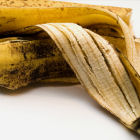Daniela Hirschfeld : 17 March 2011
 Flickr/Karl Faktor
Flickr/Karl Faktor
The peels can perform even better than conventional purification materials
[ Banana peels can be used to purify drinking water contaminated with toxic heavy metals such as copper and lead, according to a study.
Researchers from the Bioscience Institute at Botucatu, Brazil, said that the skins can outperform even conventional purifiers such as aluminium oxide, cellulose and silica. These have potentially toxic side effects and are expensive.
The team's method follows previous work that showed that plant parts, such as apple and sugar cane wastes, coconut fibres and peanut shells, can remove toxins from water.
These natural materials contain chemicals that have an affinity for metals.
"I was at home eating bananas when I had the idea: 'Why not make something with this?'" Gustavo Rocha de Castro, a researcher at the institute and co-author of this study, told SciDev.Net.
De Castro and colleagues dried the peels in the sun for a week, ground them and added them to river water containing known concentrations of copper and lead. They found that the peels absorbed 97 per cent of the metals after just one hour.
The peels were tested in the lab and worked perfectly. Eventually their efficiency reduces, at which point the metals should be removed from the skins so that they can be disposed of safely.
Castro said that, although the peels were tested only on copper and lead, the material could also work on cadmium, nickel and zinc.
But he warned that this sort of filter is better suited to industrial purposes and cannot be used for water purification at home as the extraction capacity of banana skins depends on the particle size of the heavy metals — and this is difficult to measure.
Dimitris Kalderis, a wastewater treatment expert at the Department of Environmental Engineering in the Technical University of Crete, Greece, said: "The results are very promising, and the banana peel process has proven to be a cost-effective and quick alternative to conventional methods".
"I think that a small automated system to use either at home or at a central point for multiple families could be developed. The knowledge is there, what we need right now is innovation and construction."
The study was published in Industrial & Engineering Chemistry Research last month (16 February).
http://www.scidev.net/en/news/banana-peel-can-purify-water-say-scientists.html
 Flickr/Karl Faktor
Flickr/Karl FaktorThe peels can perform even better than conventional purification materials
[ Banana peels can be used to purify drinking water contaminated with toxic heavy metals such as copper and lead, according to a study.
Researchers from the Bioscience Institute at Botucatu, Brazil, said that the skins can outperform even conventional purifiers such as aluminium oxide, cellulose and silica. These have potentially toxic side effects and are expensive.
The team's method follows previous work that showed that plant parts, such as apple and sugar cane wastes, coconut fibres and peanut shells, can remove toxins from water.
These natural materials contain chemicals that have an affinity for metals.
"I was at home eating bananas when I had the idea: 'Why not make something with this?'" Gustavo Rocha de Castro, a researcher at the institute and co-author of this study, told SciDev.Net.
De Castro and colleagues dried the peels in the sun for a week, ground them and added them to river water containing known concentrations of copper and lead. They found that the peels absorbed 97 per cent of the metals after just one hour.
The peels were tested in the lab and worked perfectly. Eventually their efficiency reduces, at which point the metals should be removed from the skins so that they can be disposed of safely.
Castro said that, although the peels were tested only on copper and lead, the material could also work on cadmium, nickel and zinc.
But he warned that this sort of filter is better suited to industrial purposes and cannot be used for water purification at home as the extraction capacity of banana skins depends on the particle size of the heavy metals — and this is difficult to measure.
Dimitris Kalderis, a wastewater treatment expert at the Department of Environmental Engineering in the Technical University of Crete, Greece, said: "The results are very promising, and the banana peel process has proven to be a cost-effective and quick alternative to conventional methods".
"I think that a small automated system to use either at home or at a central point for multiple families could be developed. The knowledge is there, what we need right now is innovation and construction."
The study was published in Industrial & Engineering Chemistry Research last month (16 February).
http://www.scidev.net/en/news/banana-peel-can-purify-water-say-scientists.html











No comments:
Post a Comment